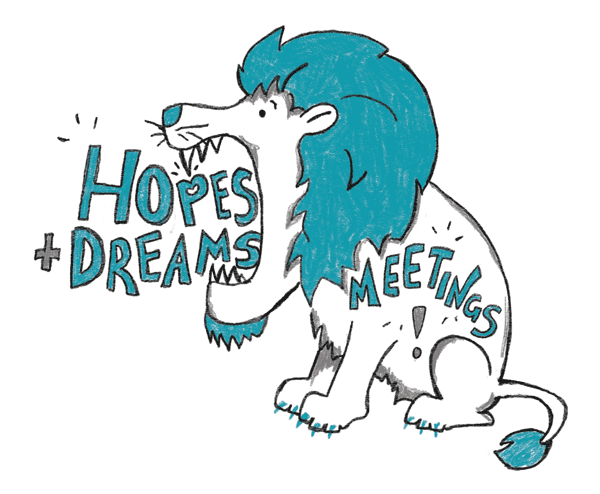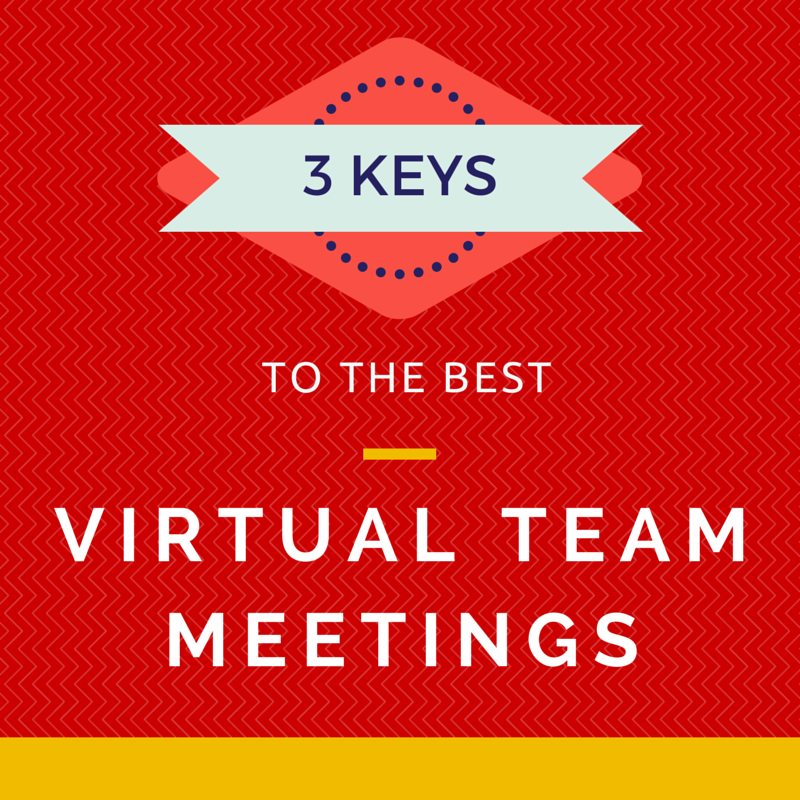The Essential Project Kickoff Meeting Agenda
How we begin matters.
In the life of every project there is a time before, when the project exists as a possibility. From this possibility, we craft our intentions for the project.
We envision what could be, and we fear what might happen. At some point, perhaps when a contract gets signed or a team comes together, the project transitions from a possibility to an inevitability.
We mark the project’s official beginning with a project kickoff meeting.
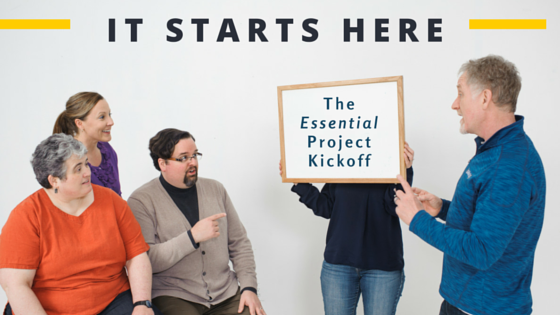
How we kick-off a project matters.
We know that even if we have a fabulous beginning, the project can run into adversity later and fail. But when we bring a project to life without really preparing for its start, into a team that neglects or resents or simply doesn’t know how to care for the project, the likelihood of failure is so much higher.
Project Kickoffs for Princes and Paupers
If you look for guidance on how to run a kickoff, you’ll find they come in two distinct flavors.

A lucky few projects start with a grand festival for their kickoff. The project teams reserve one or more days to come together, conducting workshops and games and serious investigations into how they can ensure the project starts out with the best possible resources and support available.
These interactive kickoffs focus the collected experiences and skills of the whole team on the new project’s success right from the start, greatly reducing the risk that the project will fail because a detail was missed or an instruction was misunderstood. Project kickoff workshops are a wonderful beginning.
For most projects, though, we can’t afford this kind of elaborate beginning. And for some, the pomp is overblown. So rather than host an all-day workshop, many leaders of new projects pull together all the details they can find about the project requirements and scope and risks and timeline.
For their kickoff, they gather the project team, walk them through everything they know then send them off, hoping they didn’t miss anything too important. Hoping the team paid attention.
Related: How to Lead a Successful Project Retrospective Meeting
Sometimes this works. Often, it’s only marginally better than sending email. It’s sometimes interesting, but hardly energizing, because in this kind of kickoff the teams did not work together to create anything and were not asked to do much more than nod along. These kickoffs result in teams that stay lightly connected and lightly accountable for the project’s success.
Finding a happy medium
“Tell me and I’ll forget; show me and I may remember; involve me and I’ll understand.”
Chinese Proverb
My team doesn’t do high-end design and marketing projects. We don’t build highways or plan space missions. Most of the projects we run take less than 6 months and have fewer than 20 people actively working on them.
But we still need a way to get these projects started with the whole team invested and contributing to the project’s success right from the start. After fifteen years running projects, we’ve found a consistent way to do just that.
Goals for the Essential Project Kickoff
Our project kickoff meeting is designed to accomplish these goals:
1. The kickoff must ensure everyone understands the project goals and constraints.
We’re talking about the basics here: major deliverables and responsibilities. We discuss logistics, scope, and timeline at a high-level only – just enough to make sure we know the project’s boundaries.
Our projects run better when the people actually doing the work figure out the details together, which they’ll do after we achieve a shared vision in the kickoff.
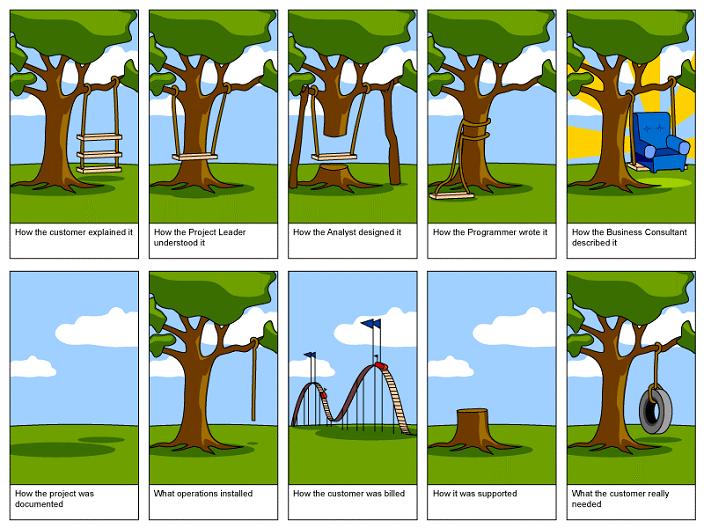
2. The kickoff must involve everyone (especially the project sponsors) in discovering and embracing what they need to do to make the project a success.
When someone hires you to do a job, they’re hiring you because you’re the expert and they don’t have time to figure it out for themselves. Yet without the critical knowledge and support of the person in charge, the project can’t succeed.
Lots of project sponsors don’t realize this. They expect you to take the requirements, maybe send the occasional status update, then emerge later with the happy results. They don’t know that you have no idea how their legal review process works, or that they hate the color orange. These are assumed facts for them, which it never occurs to them to mention.
This kickoff brings those assumptions out and gets everyone involved in adjusting the project plans to match.
3. The kickoff must be engaging and efficient.
We don’t run projects with kindergarteners, so no one should ever read out loud to the group. The format must emphasize dialogue over review.
Ideally, the whole meeting should last approximately 1 hour. Sometimes we beat this time, sometimes we go a bit longer, but this meeting never runs more than 1 1/2 hours.
4. The kickoff must work as an online meeting.
Whenever possible, the kickoff should be a face-to-face meeting. We build and sell online meeting software, and even we prefer face-to-face for these meetings.
Usually, though, this isn’t practical for most projects, so our kickoff must work as an online session.
The Essential Project Kickoff Meeting Agenda
I love ♥♥♥ running this meeting.
This meeting is an adventure; a mini-drama. Every time, no matter how small or simple or boring the project, we learn something new in this meeting. People who normally barely pay attention start to offer ideas. Clients volunteer to tackle issues, find funding, and hunt down resources. New opportunities arise, and catastrophes are averted.
The key lies in the 5 part agenda and the use of 3 specialized meeting techniques that create the necessary energy and momentum.
The Agenda
- Introduction
- Discuss: When this Succeeds
- Project Logistics
- Discuss: Why Might this Fail
- Review & Confirm Next Steps
What Happens During the Meeting
1. The Introductions
The introductions set the tone.
We start first by introducing the project itself, with a quick overview of the project goals and why it matters to the business. This is the scenario.
Then each person introduces themselves, stating their name and role. We also ask each person to share the one key thing they want to get out of the meeting. With that, everyone present suddenly has a declared stake in what happens next. We have our players.
Finally, we quickly confirm the agenda, making sure we have a way to address everyone’s important question.
The Setup
Agenda Item 2. Discuss: When this Succeeds
Now we ask the project stakeholders a question, and discuss each answer. The question is designed to get a clear idea of what project success really means to the people who will approve the work. It goes something like this.
“Let’s assume this project meets the goals and is a wild success. When you sit down for your review 3 months after the project launch, and you’re reviewing the projects you worked on and the impact they had, what will you be proud to share about this project? What will it have done for you and the organization?”
This question is based on Luke Hohmann’s “Remember the Future”. To work really well, we spend time before the meeting getting this question just right using Michael Wilkinson’s “Secret of the Starting Question” as a guide.
I always learn something important during this discussion. Sometimes I’ll learn about big missing requirements – grand aspirations or misguided assumptions. Sometimes we hear important details that will shift our approach. One client said the project would be a success as long as nothing broke and they didn’t have to think about it ever again.
This exercise is the most efficient way we’ve found to really understand why (and if) a client cares about the project outcome.
Rising Action: The Plan
Agenda item 3: Project Logistics
With a much clearer vision of success before us, we talk about the logistics.
It’s important to prepare this information in advance and send it with the agenda. That way, people can read it for themselves, leaving the meeting time for questions or corrections.
The level of detail varies by the project, but we never want to spend more than 20 minutes on this.
For the projects I run personally, I usually cover:
- Scope: what’s in, what’s out
Remember, we just talked about everyone’s grand vision of success. Immediately jumping into scope provides a fast and visceral gut check for everyone. - Key Dates
Just the big ones. Detailed project plans come later. - Who Does What
I use a modified RACI matrix for this. It’s simple to explain, covers the main points of contention, and fits nicely on a slide. You might also consider one of these methods for documenting who does what on your cross-functional team.
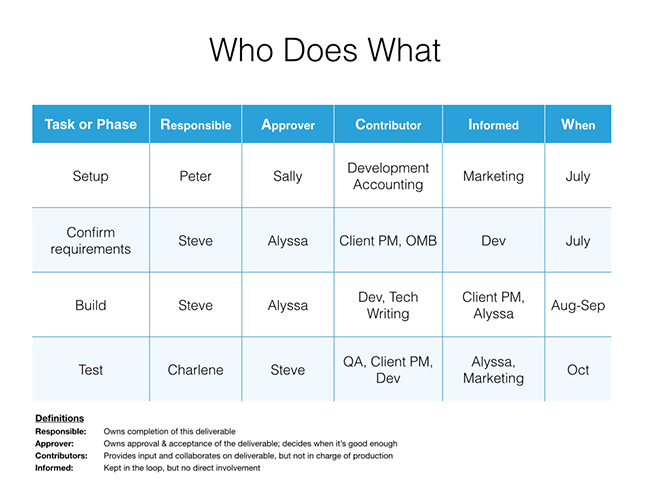
- Systems of Record
Where people can find documents, project plans, or whatever else the project needs. - Communications
When to send email, when we’ll meet, etc.
Then, it’s time for…
The Climax: Pre-Mortem
Agenda Item 4: Discuss: Why Might this Project Fail
We started by asking people to invest in the meeting by stating a personal meeting goal. Then we explored how great the project might be, helping everyone connect more strongly with the project itself. Next, we dove into the practicalities so we could all appreciate the constraints in place.
At this point, the team is rooting for the project. It’s time to get them actively working on protecting that success using our final meeting technique: the pre-mortem. To start, we might say something like:
“Now we know everything we can at this point about this project, about what it will take to succeed, about the deadlines and the team involved. Take a moment to think about other projects you’ve worked on like this in the past, and everything we must accomplish to make this project a success. Based on your experience, what might go wrong and cause the project to fail?”
It sounds like a downer, doesn’t it?
In reality, the pre-mortem is project magic. Together the team will address the most likely and preventable causes of project failure. Now your project sponsor will realize that they need to coordinate with the marketing team. The developer brings up an impending audit. You find out a key contributor is leaving on sabbatical. All kinds of important stuff comes out during this discussion.
But rather than bringing the group down, what we see is people in the meeting proactively volunteer to head off these issues. They start working as a team to address these new threats and save the project, because you’ve helped them connect with it’s success.
Be ready to write down action items from this one.
Resolution: Closing and Next Steps
After you complete the pre-mortem, close out the meeting by reviewing what you’ve accomplished together.
First, make sure you’ve addressed all the important items people brought up in the introductions. This shows respect for each person’s goal, and makes sure nothing important gets missed.
Then, review new action items. For each item, confirm: Is the action item clear and correct? Does it have the right owner? Does it have an appropriate due date?
Finally, confirm the next meeting date and time, and thank everyone for their efforts.
Try this project kickoff template for your next project and share your experience
Anyone with a Lucid Meetings account can find a complete project kickoff meeting template in the template gallery. It includes the project kickoff agenda you can run online, a PowerPoint template for presenting the project logistics in agenda item 3, pre-filled meeting invitations, and a Facilitator’s guide that explains how to prepare for the kickoff in detail.
If you don’t have a Lucid account, we’ve also put together the project kickoff meeting agenda template as a Word document that you can download.
Then, we’d love to hear from you. What works best in your project kickoffs?

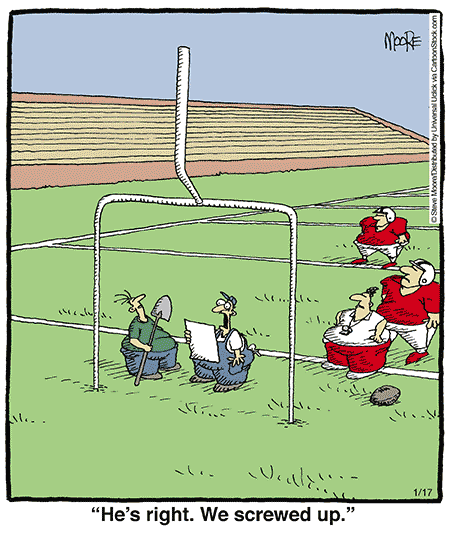 Source:
Source: 
